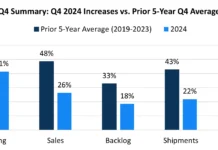by Ashley Burleson, membership and engagement manager
MAPP
 Compared to 2016, more than half (57 percent) of jobs in the US plastics industry experienced wage increases above the current inflation rate of 1.9 percent. Across the board, plastics manufacturing positions, on average, experienced a 2.0 percent increase in compensation, according to the most recent Wage and Salary Report published by the Manufacturers Association for Plastics Processors (MAPP).
Compared to 2016, more than half (57 percent) of jobs in the US plastics industry experienced wage increases above the current inflation rate of 1.9 percent. Across the board, plastics manufacturing positions, on average, experienced a 2.0 percent increase in compensation, according to the most recent Wage and Salary Report published by the Manufacturers Association for Plastics Processors (MAPP).
Now in its 15th year, MAPP’s annual Wage and Salary Report analyzes data collected from plastics executives and human resources personnel on reported wages of nearly 60 different job classifications within plastics manufacturing organizations. The 2017 report includes data from more than 200 US plastics manufacturing companies, representing just shy of 40,000 full-time and part-time employees.
 While the 2.0 percent increase in compensation was the average, skilled labor positions are continuing to see a much larger increase in compensation than other positions. According to this year’s study, CNC operators/machinists, mold/die setters, mold maintenance, production schedulers, secondary operations/assembly associates and warehouse material handlers all experienced greater than a 5.0 percent increase in compensation – not surprisingly, as the latest information from the Bureau of Labor Statistics puts the current US unemployment rate at 4.2 percent.
While the 2.0 percent increase in compensation was the average, skilled labor positions are continuing to see a much larger increase in compensation than other positions. According to this year’s study, CNC operators/machinists, mold/die setters, mold maintenance, production schedulers, secondary operations/assembly associates and warehouse material handlers all experienced greater than a 5.0 percent increase in compensation – not surprisingly, as the latest information from the Bureau of Labor Statistics puts the current US unemployment rate at 4.2 percent.
As the unemployment rate is decreasing, the need for talented workers continues to increase. According to a recent article by Reuters News Agency, manufacturing jobs in the US are increasing each month, and 83 percent of participants in the MAPP study indicated their company plans to hire more employees over the next 12 months. Plastics processors across the country are feeling the effects of the current unemployment rate and the need for skilled workers, and these processors are working diligently to find and retain individuals. Now more than ever, having a steady and stable workforce gives organizations a competitive advantage in the industry. It is that need to compete for skilled workers that has forced many plastics processors to realize the importance of making adjustments in compensation.
 Plastics companies also are working to gain a competitive advantage by changing their shift structures. In just three years, the number of plastics executives who indicated their company runs one shift was cut in half. Today, approximately 85 percent of companies run at least three shifts in various iterations compared to 67 percent three years ago. The need to staff second and third shifts puts further pressure on manufacturers to increase pay in these areas. According to this years report, 82 percent of companies running three shifts compensate second- and third-shift employees with an increased pay differential. These pay differentials range from less than 25 cents to greater than one dollar per hour with the most common being between 26 and 50 cents per hour.
Plastics companies also are working to gain a competitive advantage by changing their shift structures. In just three years, the number of plastics executives who indicated their company runs one shift was cut in half. Today, approximately 85 percent of companies run at least three shifts in various iterations compared to 67 percent three years ago. The need to staff second and third shifts puts further pressure on manufacturers to increase pay in these areas. According to this years report, 82 percent of companies running three shifts compensate second- and third-shift employees with an increased pay differential. These pay differentials range from less than 25 cents to greater than one dollar per hour with the most common being between 26 and 50 cents per hour.
It is not just skilled labor personnel who are experiencing increased compensation – other positions, such as marketing directors/managers, project engineers and quality engineers, also saw an above-average increase in compensation. These changes could potentially be due to an increased focus on marketing within manufacturing and the increased demand and pressure to effectively manage projects and deliver quality products to customers.
However, many of the staff-level positions inside of plastics organizations are seeing stagnant or below average increases. For the first time since 2009, the nine staff-level positions considered most common in plastics operations (general manager, engineering manager, human resources manager, IT manager, maintenance manager, plant manager, purchasing manager, quality manager and sales manager) did not see an increase equal to or greater than the current inflation rate. However, this trend is not expected to continue. Many experts are already anticipating compensation rates for these roles to increase in the near future.
For more information on MAPP’s Wage and Salary Report or to purchase this year’s report, visit www.mappinc.com.




